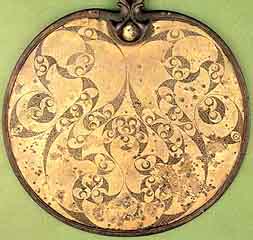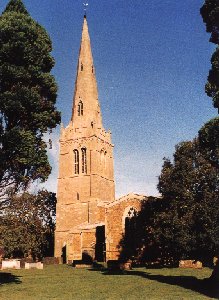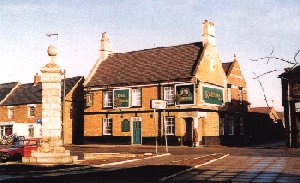.
Desborough has the appearance of being a relatively recent town but its history can be
traced back to the Bronze Age four thousand years ago.
A major employer is Rigid Containers with other diverse companies on the small industrial
estate on Pipewell Road. The main shopping area along the High Street and Station Poad has
a good range of shops, two public houses, the Kings Arms, the George Hotel and a Public
Library. Other facilities include a leisure centre offering a range of sporting activities
and a park with a bowling green, football pitch and play area.
History of Desborough:
By the Iron Age, Desborough had become, it seems, the base of a locally important family
or lineage. Items accompanying burials all point to prestige goods and the display of
wealth, for example the Desborough Mirror, which is now in the British Museum.

In a field to the south of the church known as the Damms, are traces of eath banks which
may be all that remain of the settlement´s Anglo-Saxon fortifications and, reputedly, the
site of a battle between the Saxons and marauding Danes. In fact the name Desborough may
derive from "Disburg" meaning "sacred fortified place" In the Domesday
Book of 1086, it is variously referred to as "Dereburg", "Desburgh"
and "Deisburg" meaning "place of judgement". Either way, it seems that
Desborough was a locally important power base.

St. Giles Church
The oldest remaining building in the town is undoubtedly St.
Giles´Church, built around 1225 AD most likely on the site of an earlier Saxon one. The
church is light and airy and contains interesting sculptures, in particular the decorated
Tudor canopy above the Rood screen staircase displaying Tudor roses and the "Stafford
Knot", the emblem of the powerful Stafford family who owned much of the land around
Desborough.
The town has other buildings of architectural merit. Two are close by the church:
eighteenth centery Church House and Desborough House, an elegant early nineteenth century
stuccoed building (now offices) with a classical facade featuring graceful Doric pillars.

The old town cross
In High Street stands the old town cross rather resembling a gateway pillar being a
tall square column surmounted by a stone phere.
Between the fifteenth and eighteenth centuries, the Poultons were Lords of Manor
Ferdinando Poulton (b. 1536), an eminent lawyer and a Roman Catholic at a time of
religious intolerance, was reputed to have been involved in the "Gunpowder Plot"
(his near neighbour Francis Tresham of Rushton Hall was found guilty of involement and
died in prison). His descendant, Charles Poulton, became a jesuit Priest and also suffered
for his beliefs, having to live rough in wood to escape persecution. He was eventually
arrested in 1688 and, despite his age (he was seventy years old), was sent to the infamous
Newgate Goal where he died shortly afterwards.
The area produced other men willing to stand by their religious convictions such as
Desborough´s Non-Conformist vicar, Reverend Thomas Browning who, in 1662, was forced to
leave his church and became Minister of Rothwell´s Independent Church.
It was at this time that the town became a centre for spinning and weaving wollen and
linen fabrics. Local wool was used to produce fine cloth and flax for linen was grown
beside Ise Brook. The industry suffered when Banbury became a major weaving centre with
the loss of many jobs in the mid-nineteenth century. To counter this, silk weaving was
introduced and the first factory opened in Paddock Lane in 1832. This in turn was shortly
to be replaced by footwear manufacture which became one of two major employers in the
town, the other being the Desborough Co-operative Society.
The Society was founded in 1863 by local men including John and Ruben Coe, Charles Allen,
John Leago, Samuel Ginns, William Fenton and Robert Marlow, to counter exploitation of
weeavers by their agents who found them work but insisted that they bought their groceries
from shops that the agents owned. Many weavers found themselves in debt as a consequence.
The Co-operators answer was to open their own shop and give loans to pay off existing
debts. The enterprise took off and the Society soon opened other shops. Two years after
its foundation in 1863, the Desborough Co-operative Society became affiliated to the
national Co-operative Wholesale Society and opened a large local factory producing corsets
and lingerie, continuing to do so up until quite recently.


